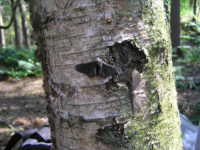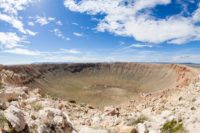Besides the arrogance of such statements, this argument has no footing and should be cast off. Mainly, those who make this claim usually define “educated people” as those who accept evolution. Any who disagree fail the test, no matter what their background (e.g., if we follow this ideology, Isaac Newton must have been uneducated). There are many lists of well-educated scholars who look to the Bible for answers (here’s one)—and we could point out Darwin’s own deficit of formal education (he earned a bachelor’s in theology). But the bigger issue is that education—or lack thereof—does not guarantee the validity of [More]
By Creation Moments Richard Dawkins believes he has found an organ system, which is badly designed, and so proves that no god could have designed it. He has popularized this accusation so widely that atheistic websites and forums simply quote the example, as if it were proven. He refers to the color receptors on the retina of the vertebrate eye. read more …read more Source: Creation Moments
We’re expanding again at the Ark Encounter. Near the Ark, we’re building a 2,500-seat auditorium that will allow us to host workshops, conferences, special speakers, and other programs. Though Legacy Hall, our auditorium at the Creation Museum, seats 900, this bigger auditorium at the Ark will allow us to host even larger events here in Northern Kentucky. Read More: Construction Starts on Ark Encounter Auditorium | Answers in Genesis
Today’s global population contains people groups with a wide range of skin color. For many years, creation scientists have maintained this variety is due to the inherent created diversity in the original human couple as well as the dispersion of people groups at the Tower of Babel. New research in skin color genetics confirms this biblical narrative. More… …read more Source: icr.org
Thirty-eight fossil lizards reckoned to be 20 million years old-so well-preserved you can see whether their eyes are open or shut. …read more Source: creation.com
By Creation Moments I often think that all Christians should be interested in astronomy. That does not mean that I think you should be experts in how stars work, or how light travels. But the Psalmist says that “the heavens declare the glory of God, and the sky above proclaims his handiwork”. read more …read more Source: Creation Moments
It’s exciting to see the thousands of people who pour into our two world-class attractions, the Ark Encounter and Creation Museum, each day here in Northern Kentucky. Thousands daily are learning about the truth of God’s Word and the gospel, and I enjoy often getting to meet with these guests from across the United States and around the world. We recently had a special guest visit our attractions—well-known pollster George Barna. Read More: George Barna Visits the Creation Museum and Ark Encounter | Answers in Genesis
If you believe in aliens from outer space, it may just be a religious impulse. A recent Scientific American article by Michael Shermer (founder of the Skeptics Society and the publisher of Skeptic magazine) highlights a recent set of studies at North Dakota State University (NDSU) that found “those who report low levels of religious belief but high desire for meaning in life show greater belief in ETIs [Extraterrestrial Intelligence].” Of course, everyone is religious, including atheists and skeptics—they just place their belief in an evolutionary worldview, naturalism, and humanism, instead of in Christ and his Word. Romans 1 [More]
With the secular evolutionary agenda gaining such momentum, it may be tempting to think ‘it’s Game over’. But look behind the showiness and bravado, and the claims are empty. …read more Source: creation.com
By Creation Moments Every so often, we need to return to the topic of peppered moths, which we have featured a number of times before. Previous Creation Moments have explained why Peppered Moths are not an example of evolution, and how, in the 1980s, it was found that the famous photos showing light and dark moths on light and dark tree trunks had, in fact, been staged. read more …read more Source: Creation Moments
How should Christians think about tragedies like the Texas church shooting? …read more Source: creation.com
Recently, the asymmetry matter/antimatter problem, one of the most serious objections to the Big Bang model, just got a little worse. More… …read more Source: icr.org
Unscrambling the clues at a fossil site in Argentina which contains thousands of yet-to-be-hatched dinosaurs that have been quickly buried. …read more Source: creation.com
A sneak preview of the editorial from the soon-to-be-released Creation magazine. Subscribers will be delighted with the magazine’s powerful content and brilliant graphics. …read more Source: creation.com
A guest column by a pastor that took biblical creationists, in particular AiG President Ken Ham, to task for supposedly being antiscience, appeared recently in a Holland, Michigan, newspaper. In Ken’s absence (he has been in England to speak at a conference), we asked our astronomer Dr. Danny Faulkner (who eventually joined Ken in England) to respond on Ken’s behalf. It made sense too because Dr. Faulkner’s PhD in astronomy made him highly qualified to address the contents of the pastor’s column. However, the managing editor told us that the newspaper has a policy of “not print[ing] letters to [More]
By Sarah Chaffee On this episode of ID the Future, hear part 2 of a lecture given by David Snoke at a conference sponsored by the Christian Scientific Society. In this segment, Dr. Snoke, professor of physics and astronomy at the University of Pittsburg, discusses the relationship between information and entropy. Your browser does not support playing Audio, please upgrade your browser or find our podcast on podOmatic Download Episode …read more Source: id the future
By Creation Moments The Solar System has seen many impacts. On so many bodies of the Solar System, these impacts have produced craters. It is well known that the surface of the Moon contains many craters, which are thought to have been formed when a meteorite hit the Lunar surface. However, the Moon is not alone. read more …read more Source: Creation Moments
Our Western cultures no longer value human life as they once did. The unborn, the disabled, the elderly, and the terminally ill are increasingly viewed as burdens on society instead of having intrinsic value simply because they are humans, made in the very image of God (Genesis 1:27). A recent article in New Scientist reminded me of this truth. This article was called “Life Extension May Prove to Be a Double-Edged Sword.” The subtitle read, “Today’s middle aged people could routinely live to 120 or more. That means we have time to prepare.” The article claims that antiaging research [More]
A refreshing assessment of Genesis that biblical creationists should find useful. …read more Source: creation.com
A drop of rain brings on an explosive reaction that leads to new life. …read more Source: creation.com
By kpennock On this episode of ID the Future, to celebrate Michael Denton’s newest book, The Wonder of Water, we bring you a conversation between Ray Bohlin and Howard Glicksman on the body’s wondrous control systems for using water. Dr. Glicksman is a medical doctor and author of an extended series of posts at Evolution News & Science Today, “The Designed Body.” Your browser does not support playing Audio, please upgrade your browser or find our podcast on podOmatic Download Episode …read more Source: id the future
Five hundred years ago this month, the Reformation was initiated by a German priest and professor named Martin Luther and continued by others such as Calvin and Zwingli. Luther’s nailing of his famed 95 Theses to a church door in Wittenberg began the Reformation in October 1517. It was a movement that called the church back to the authority of God and away from the fallible opinions of man, which had severely compromised the clear teaching of the Word of God. The Bible-upholding movement was so powerful that today we are still experiencing the effects of this historical earthquake [More]
We help a questioner think through an unusual question within a biblical framework. …read more Source: creation.com
By Sarah Chaffee On this episode of ID the Future, we continue to celebrate geneticist Michael Denton’s new book, The Wonder of Water, with this reposted interview where Denton reflects on the concept of bottom-up, versus top-down, causation, and which is the better explanation for the world we live in. Your browser does not support playing Audio, please upgrade your browser or find our podcast on podOmatic Download Episode …read more Source: id the future
By kpennock An actor in Hollywood raises the important question of when people should and shouldn’t be skeptical of claims made in the name of science, inspiring a response from political scientist John West, author of Darwin Day in America. This conversation was taped live in Hollywood during a discussion after the final performance of Disinherit the Wind, a play that tells the story of a neurobiologist who sues his university for the right to challenge neo-Darwinian evolution. Your browser does not support playing Audio, please upgrade your browser or find our podcast on podOmatic Download Episode …read more Source: [More]
On this day in 1517—exactly 500 years ago—the church and culture were changed forever when a defiant monk nailed his 95 Theses to the door of Castle Church in Wittenberg, Germany. This act by Martin Luther is considered the beginning of the Protestant Reformation, a period that would radically reform the church as she returned to God’s Word, not man’s tradition, as the authority for life and practice. A World Primed for Reform Much has changed over the five centuries since Luther’s bold stance on God’s Word. But the world of Luther is one that parallels our own in [More]
Editor’s Note: First published in St. Louis MetroVoice 5, no. 2 (February 1995). The bitterest pill to swallow for any Christian who attempts to “make peace” with Darwin is the presumed animal ancestry of man. Even many Christians who uncritically accept evolutionary dogma as “God’s way of creating” try to elevate man and his origin above that of the beasts. Evolutionists attempt to soften the blow by assuring us that man didn’t exactly evolve from apes (tailless monkeys) but rather from ape-like creatures. This is mere semantics, as may be seen from the fact that many of the [More]






























